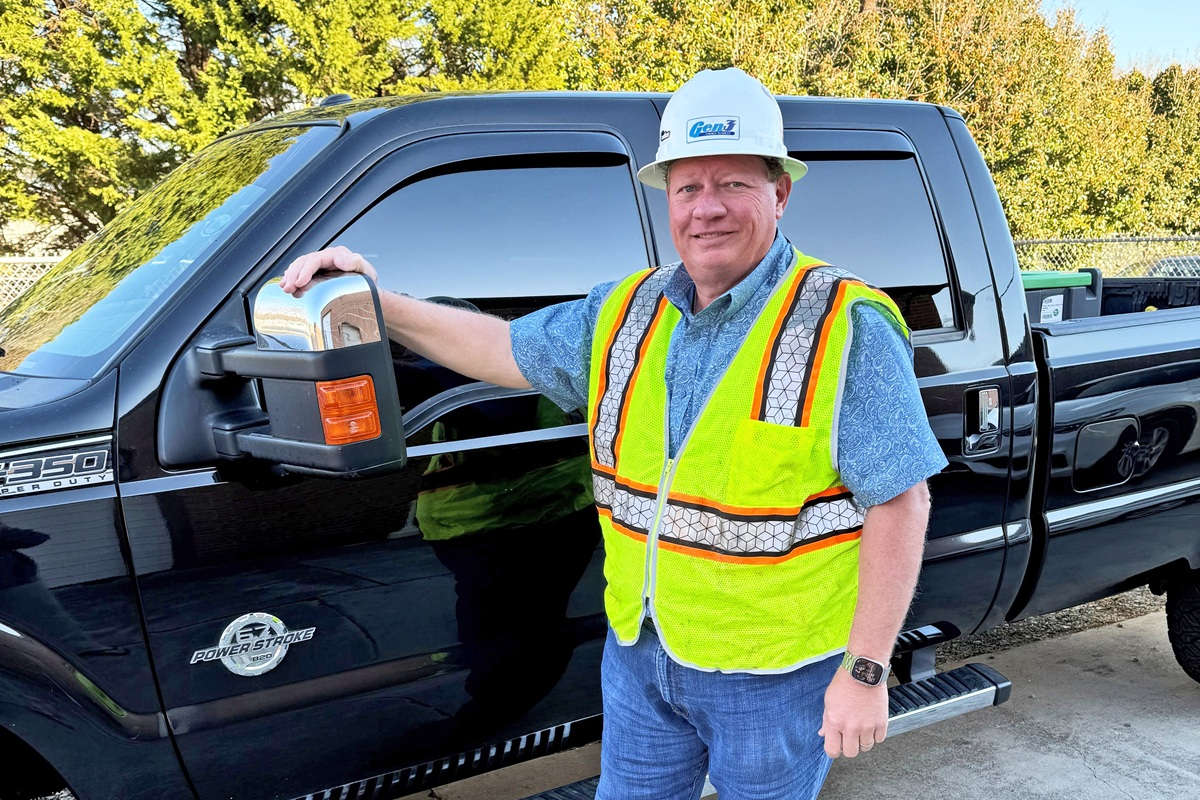Ride-On Trenchers Offer Diverse Attachment Options

When trenches are long, operators would rather ride on than walk behind a trenching machine, and ride-on trenchers allow them to be more productive. Smaller ride-on trenchers are used in residential installations whose services typically go 50 to 200 ft, and larger systems are used in commercial construction projects where properties may need trenches that are 200 to 1,000 ft long.
Ride-On Advantages
It is possible to make a trench with attachments on other equipment like mini excavators or skid steers, but ride-on trenchers offer the fastest and most efficient way to trench and install a utility service. Jon Kuyers, Global Product Manager, Underground, for Vermeer, says that compared to mini excavators, which are designed for digging holes and use hydraulic hammers to break rock, ride-on trenchers with rock saws are faster and leave a narrower, more even surface. With vibratory plow attachments, the ground needs much less restoration when using ride-on trenchers.
Front attachments on trenchers make them more flexible than other equipment. Backhoes or reel carriers can carry pipes or cables to be installed, and, depending on the size, can lift or dig deeper pits for anything that is required for the service, like an electrical transformer box.
Andrew Schuermann, Trencher Product Manager at Ditch Witch, says that even for short jobs, it is easier for a beginner operator to create a straight trench with a ride-on trencher than with other equipment not specifically designed for trenching.
Ride-on trenchers also have better maneuverability, which can be a concern when working in tight spaces on residential jobs. According to Josh Beddow, Product Marketing Manager at Toro, clearances on a jobsite limit the size of the chassis and engine needed, and they dictate how fast and how much can be dug. Manufacturers design ride-on trenchers to have maximized digging performance on as small machine as possible.
 Features That Users Love
Features That Users Love
Over the years, ride-on trenchers have evolved to have features for operator and environmental safety, comfort and increased digging performance. Manufacturers have changed both the tractors and the digging implements.
Features such as better air filtration and safety interlocks that stop the unit when the operator leaves the seat are now common across the industry. The newest trenchers have advanced engine technologies that meet new emissions standards, and more trencher models have higher traction track options that do a better job than tires for plowing, trenching and sawing in sandy or muddy conditions.
According to Beddow, Toro recently changed plow adjustments in response to user feedback. Blades with adjustable angles now allow operators to vary the pitch while the machine is running or plowing as ground or surface conditions change instead of having to make a manual adjustment.

Another example is an aftermarket add-on that integrates ride-on trenchers with GPS to position the plow to grade. It is useful when installing drainage tiles in agricultural applications. Beddow also says Toro’s Tier 4 Final engines give a lot more data that can be used to optimize performance. “There are many opportunities that will continue to evolve as systems become more integrated and computerized,” he says.
Attachments Are Key
Trenching attachments are installed on the rear of the machine, behind the operator. The type depends on the ground conditions and the size and depth of the utility to install. Trenchers with 4- to 5-ft boom depths are used in cold regions like the Midwest to install water lines below the frost line. Vibratory plows are used to create much shallower trenches when installing cable lines, generally 1 to 2 ft deep. Rock saws are used in rocky areas of the world and to install utilities in the ground in houses that are built on concrete pads.
Trenching attachments can dig trenches up to 8 ft deep. They have a chain which digs and pulls earth out of a trench and augers that pull the dirt away from and pile it next to the trench. Centerline trenchers are the most basic trenching method, creating an open cut while remaining in a fixed position during trenching. Offset trenchers, also called traversing multi-position trenchers or dual position trenchers, allow users to mechanically move the trencher boom, which is useful when digging closer to a fence or building.

Schuermann says vibratory plows are faster and can save significant time and money for product that is able to be buried directly, without being seen, and if ground conditions allow it. For products that are grade-dependent, like sewer lines, or that need to be physically inspected in the bottom of the trench before being buried, the open cut method is used with a trencher.
“There is some amount of depth control with a vibratory plow, but it is not as accurate for grade installations as open cut methods,” Schuermann says. “Also, the plow is limited to product that is smaller than 4 in. with trenches shallower than 42 in., so anything bigger needs to use open cut methods.”
Ride-on trenchers also have other rear-mounted attachments. Combination trencher/plow attachments give operators the option to do both on the same tractor. Rock or earth saws have large wheel saws and are used for conditions that are rocky or hard to trench or plow through. They produce open cuts similar to a trencher. Microtrenchers are one of the newest attachments appearing in the last few years. They produce very narrow trenches, from 3/4 to 1 1/4 in. wide to 12 in. deep for fiber-optic communication lines in hard asphalt surfaces like roads or sidewalks.
On the front, backhoes can be attached to create starter holes or pits at the beginning or end of a job or to create an open cut the entire length of an installation. Reel carriers are used with the vibratory plow, holding poly pipe on a reel that can be installed as the machine goes.
Manufacturers offer different sized models of ride-on trenchers, and each has a dedicated attachment designed for that machine. Unlike the skid steer world where there are hundreds of attachments made by many companies to fit each unit, ride-on trenchers only accept attachments designed by the manufacturers to mount only to their tractors. Machine owners can switch attachments to use for different applications, like plowing in the summer and trenching in the winter when the ground freezes.
Tips for Selecting
When selecting a ride-on trencher, Schuermann says some contractors know what they want and ask for specific machines, but some come with their product specifications and ask for the best and most cost-effective method to install it in the ground. He recommends knowing the product that will be installed, its size and the installation depth, if it is grade dependent, whether it will need an open cut method or if a vibratory plow can be used and the ground conditions. He also says to consider the level of support and service the local dealer has. Dealers that provide a network of parts and service can impact a selection decision.
Kuyers says it’s important to know where the work will occur in order to size the right product for the application. Small or confined spaces can dictate what’s needed. Also, when deciding whether to buy or rent, he says to know how often the trencher will be used and consider purchasing if it’s around 75 to 80 percent of the time.
“Chain selection is so complex you could write a book about it,” says Kuyers. Weather conditions matter, and there are many different chains, from cup cutters for dirt applications, rotary cutters for frost, combination cup and rotary cutters, which handle mixed soil conditions, and shark chains whose cutters look like shark fins and have lower operating cost for mixed soils. “Local dealers who are experts in the local ground conditions can recommend the optimum configuration and know what other contractors in the area are using,” he says.
The same goes for selecting vibratory plow blades. There are multiple types with different configurations based on soil type. Some are designed to cut harder soils, and some have different wear parts so they’re easily replaceable in highly abrasive conditions. “Use the local dealer,” Kuyers says.
Beddow says that the beauty of the trencher is its modular design. Attachments can always be added or changed later as needed as business, ground conditions or geography changes. “Think about what the primary business will be and what attachments will be needed for that function. Tracks are another example. They are a significant investment to include at the beginning. If a contractor isn’t sure if they’re necessary, they can always be added later,” he says.
There are many places that should be inspected for excessive wear. “Vibratory plow attachments vibrate a lot, so check all the pivot pins for wear,” Kuyers says. “If there is slop or play in these strategic points, replace the bushings or the pins themselves to avoid damaging the entire attachment. The same goes for the auger; check the auger slop or play and the auger drive bearings for wear. Check the condition of the wear plates on the bottom of the trencher boom itself. If they’re worn through to the base metal, they need to be replaced or they could damage the digging chain. Use the same test at the tail end to check for slop in the idler bearing. If it moves side to side, it may be worn out or not adjusted properly.”
Make sure to optimize any used system for the local conditions, and factor these costs into the overall cost of purchasing a used system. Bring it to the local dealer to optimize the chains, blades and trencher drive sprockets for performance. Check that the bearings are tight and everything is aligned. Look at the complete digging system to ensure it works the way it should and the wear isn’t going to affect the chain.
Debbie Sniderman is an engineer, consultant and CEO of VI Ventures LLC, an engineering consulting company. She can be reached at info@vivllc.com.
Tips for Inspecting Used Ride-On Trenchers
Before buying a used trencher, Kuyers suggests finding out its history and status, similar to shopping for a used car. Look at the overall tractor, the engine, maintenance and service records; check if the hydraulic oil looks clean, when the last sample was and if the hydraulic system has been rebuilt. Look at the tires, the tire wear, the tread wear and take it for a test drive before buying (which is possible from a dealer but not always at an auction).

 Features That Users Love
Features That Users Love 


